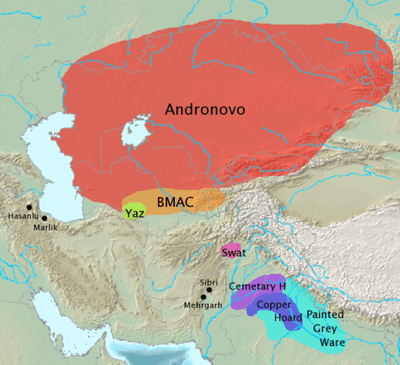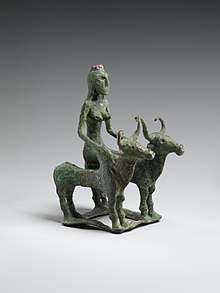Ochre Coloured Pottery culture

The Ochre Coloured Pottery culture (OCP) is a 2nd millennium BC Bronze Age culture of the Indo-Gangetic Plain, extending from eastern Punjab to northeastern Rajasthan and western Uttar Pradesh.[1] It is considered a candidate for association with the early Indo-Aryan or Vedic culture.
The pottery had a red slip but gave off an ochre color on the fingers of archaeologists who excavated it, hence the name. It was sometimes decorated with black painted bands and incised patterns. It is often found in association with copper hoards, which are assemblages of copper weapons and other artifacts such as anthropomorphic figures. OCP culture was rural and agricultural, characterized by cultivation of rice, barley, and legumes, and domestication of cattle, sheep, goats, pigs, horses, and dogs. Most sites were small villages in size, but densely distributed. Houses were typically made of wattle-and-daub. Other artifacts include animal and human figurines, and ornaments made of copper and terracotta.[2]
At some archaeological sites in the western part of its distribution, the OCP occurs alongside the Late Harappan phase of the Indus Valley Civilization, but in OCP sites farther east, there is no such direct link with the Harappan culture.[3] The OCP marked the last stage of the North Indian Bronze Age and was succeeded by the Iron Age black and red ware culture and the Painted Grey Ware culture.
Geography

Early specimens of the characteristic ceramics found near Jodhpura, Rajasthan, date from the 3rd millennium (this Jodhpura is located in the district of Jaipur and should not be confused with the city of Jodhpur). Several sites of culture flourish along the banks of Sahibi River and its tributaries such as Krishnavati river and Soti river, all originating from the Aravalli range and flowing from south to north-east direction towards Yamuna before disappearing in Mahendragarh district of Haryana.[4]
The culture reached the Gangetic plain in the early 2nd millennium. Recently, the Archaeological Survey of India discovered copper axes and some pieces of pottery in its excavation at the Saharanpur district of Uttar Pradesh. The Ochre Coloured Pottery culture has the potential to be called a proper civilisation (e.g., the North Indian Ochre civilisation) like the Harrapan civilisation, but is termed only as a culture pending further discoveries.[5]
Copper hoards
The term copper hoards refers to different assemblages of copper-based artefacts in the northern areas of the Indian Subcontinent that are believed to date from the 2nd millennium BC. Few derive from controlled excavations and several different regional groups are identifiable: southern Haryana/northern Rajasthan, the Ganges-Yamuna plain, Chota Nagpur, and Madhya Pradesh, each with their characteristic artefact types. Initially, the copper hoards were known mostly from the Ganges-Yamuna doab and most characterizations dwell on this material.
Characteristic hoard artefacts from southern Haryana/northern Rajasthan include flat axes (celts), harpoons, double axes, and antenna-hilted swords. The doab has a related repertory. Artefacts from the Chota Nagpur area are very different; they seem to resemble ingots and are votive in character.
The raw material may have been derived from a variety of sources in Rajasthan (Khetri), Bihar, West Bengal, Odisha (especially Singhbhum), and Madhya Pradesh (Malanjkhand).
Unresolved cultural relationships
Some scholars regard the OCP culture as late or impoverished Harappan phase of Indus Valley Civilisation culture, while others see it as an indigenous culture unrelated to the Harappan. V. N. Misra (in S.P. Gupta 1995: 140) regards the OCP as "only a final and impoverished stage of the Late Harappan culture" and designates this phase as "Degenerate Harappan". Together with the Cemetery H culture and the Gandhara Grave culture, some scholars believe the OCP was a factor in the formation of the Vedic civilization.
See also
References
- ↑ Upinder Singh (2008), A History of Ancient and Early Medieval India From the Stone Age to the 12th Century, p.216
- ↑ U. Singh (2008), pp.216-218
- ↑ U. Singh (2008), pp.216-217
- ↑ Cultural Contours of India: Dr. Satya Prakash Felicitation Volume, Vijai Shankar Śrivastava, 1981. ISBN 0391023586
- ↑ Ali, Mohammad (28 February 2017). "Copper axes point to an ancient culture story". Archived from the original on 25 April 2018. Retrieved 25 April 2018 – via www.thehindu.com.
- Yule, P. (1985), Metalwork of the Bronze Age in India, Munich: C.H. Beck, ISBN 3-406-30440-0
- Yule, P.; Hauptmann, A.; Hughes, M. (1992) [1989], The Copper Hoards of the Indian Subcontinent: Preliminaries for an Interpretation, Jahrbuch des Römisch-Germanischen Zentralmuseums Mainz, pp. 36, 193–275, ISSN 0076-2741
- Gupta, S.P. (ed.) (1995), The lost Sarasvati and the Indus Civilization, Jodhpur: Kusumanjali Prakashan
- Sharma, Deo Prakash (2002), Newly Discovered Copper Hoard, Weapons of South Asia (C. 2800-1500 B.C.), Delhi: Bharatiya Kala Prakashan
- Yule, Paul (2014), A New Prehistoric Anthropomorphic Figure from the Sharqiyah, Oman, in: ‘My Life is like the Summer Rose’ Maurizio Tosi e l’Archeologia come modo de vivere, Papers in Honour of Maurizio Tosi on his 70th Birthday, Oxford: BAR Intern. Series 2690